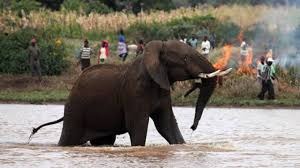The longstanding struggle between humans and wildlife has reached alarming levels in recent years, population growth and climate change exacerbate the competition for vital resources like food and water.
In an interview with a local radio, ZimParks and Wildlife national spokesperson Tinashe Farawo said this escalating conflict is threatening both communities and wildlife across the country. “Human-wildlife conflict is not a new phenomenon, but what we are worried about is the sudden increase, especially over the last few years,” said Farawo
He explained that the country, which reserves 18% of its land for wildlife, is facing significant challenges as both human and animal populations surge.
“The land is not expanding, and the clashes are rising,” he added.
Farawo said in 1980, Zimbabwe had a population of around 7 million people and approximately 40,000 elephants. Today, both populations have more than doubled, yet the available land remains the same.
This, coupled with inconsistent rainfall due to climate change, has forced animals to venture further in search of food and water, often leading to destructive encounters with human communities.
“Elephants can smell water from distances of up to 10 kilometers,” Farawo said, noting that their increasing numbers are leading to habitat loss and more frequent raids on farms and livestock.
He added “I think we’ve been doing a lot of work in terms of trying to mitigate this kind of a problem right across the country. We work closely with a lot of conservation partners that are also helping us in a very big way. We are working closely with communities and we are also encouraging farmers to grow chilli, you know elephants and chilli that are not the best for friends.”
Wild Africa chief executive officer Peter Knight echoed these concerns, stressing that as natural resources dwindle, the pressure on both humans and animals intensifies.
“I think that’s put an extra pressure on already stretched resources and as the water resources disappear, as the food disappears, that’s causing both human beings and their livestock to have to go to different areas and the wildlife that obviously can cause conflict.
Human wildlife conflict has been going on for centuries all over the world. The challenge here is to how wildlife and people can coexist and what we’ve been doing is just looking at different methods across the continent from around the world of ways that people have learned to live with wildlife.” Knight said.



